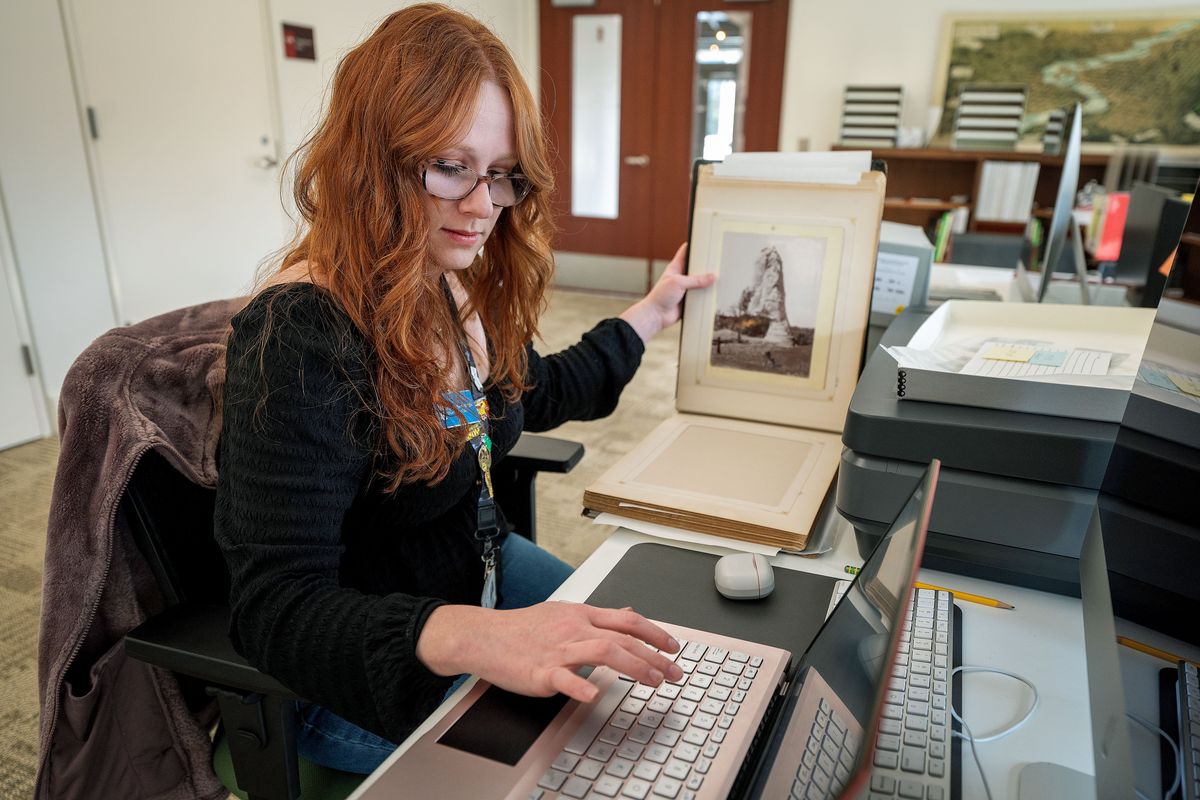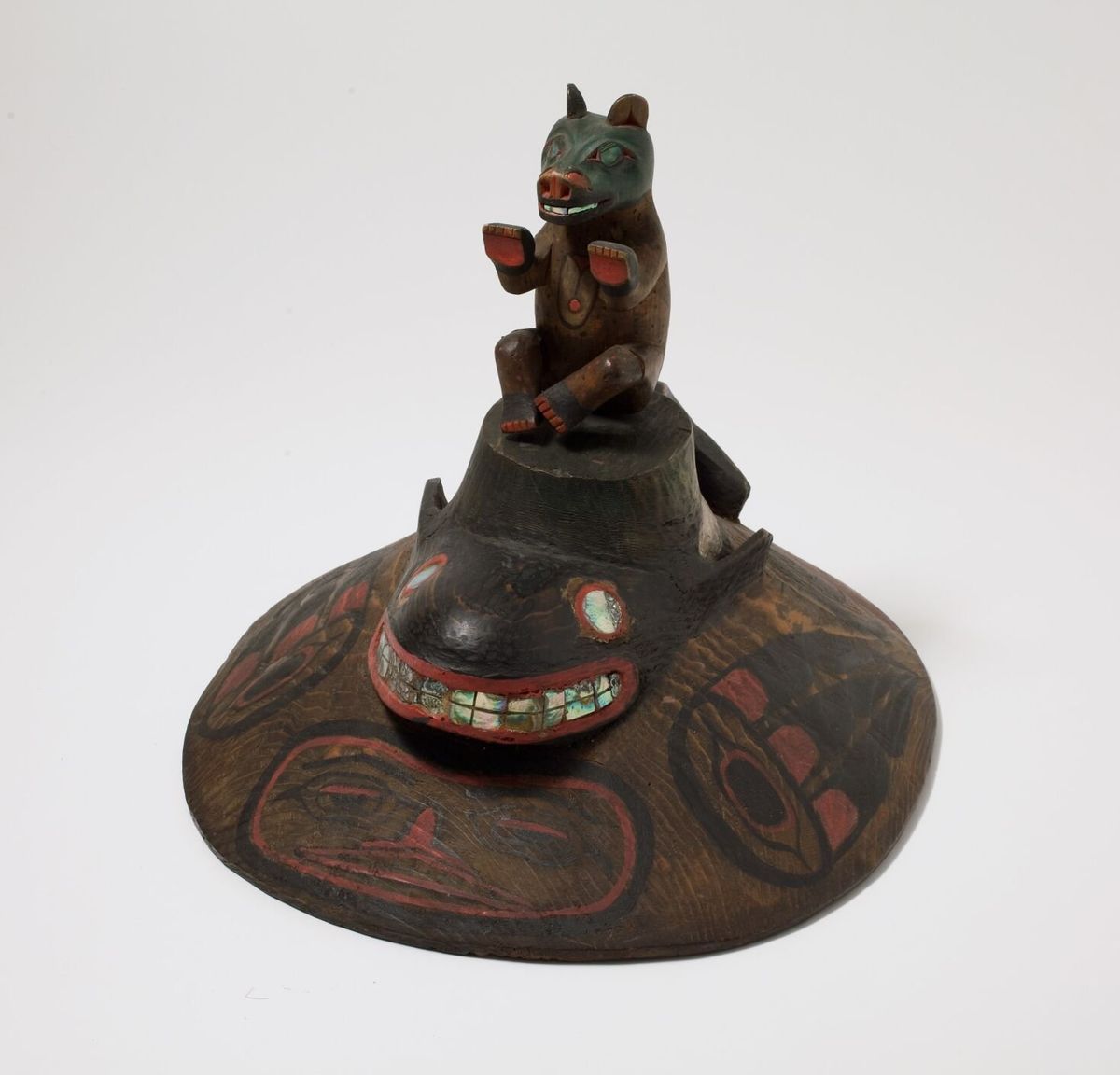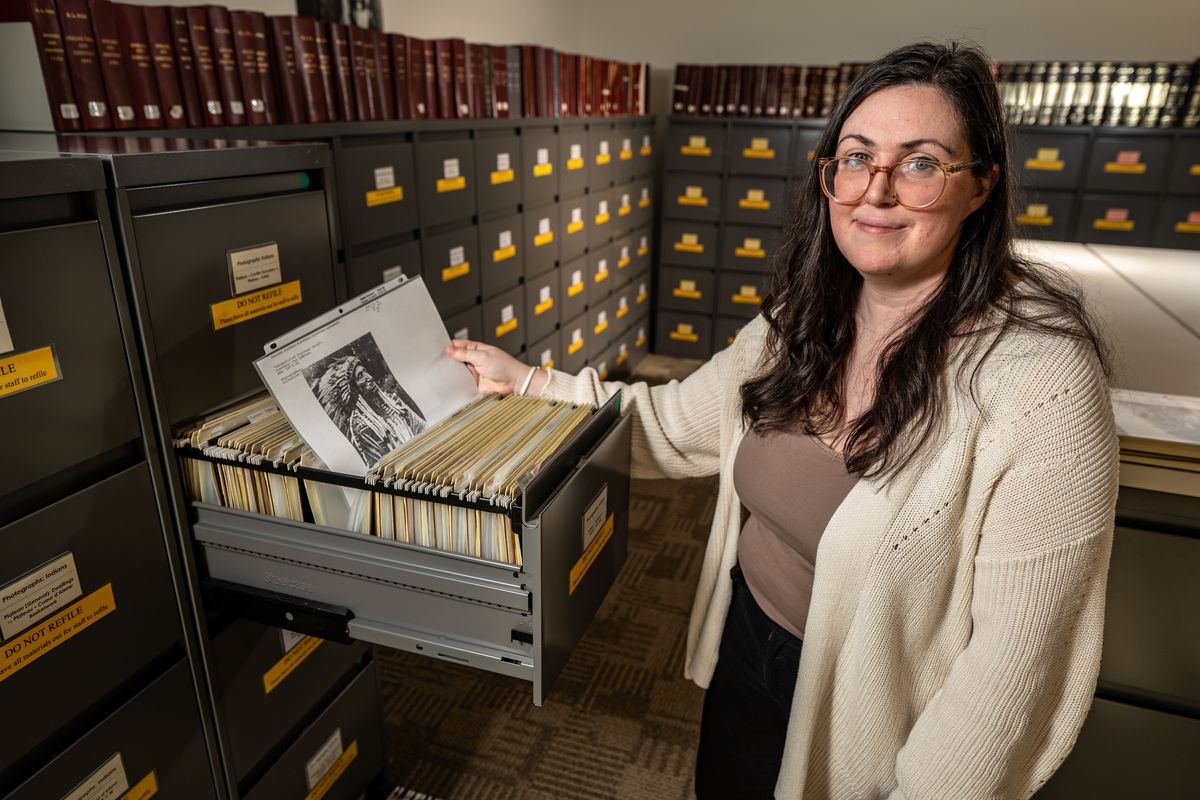Why the MAC in Spokane isn’t affected by new rules on displaying Native artifacts
“We’re trying to balance access with cultural respect,” said Northwest Museum of Art and Culture head archivist Anna Harbine. While some major museums across the country are covering or removing Native American displays, the MAC isn’t affected by new federal regulations for repatriating Native artifacts. The museum works closely with Native tribes through its advisory board, the American Indian Cultural Council. (COLIN MULVANY/THE SPOKESMAN-REVIEW)
While major museums across the country are covering or removing some Native American displays, the Northwest Museum of Arts and Culture in Spokane won’t be affected by new federal regulations for Native artifacts.
That’s because the MAC has a strong relationship with local tribes, and current exhibits have been curated with tribal input, museum executive director Wesley Jessup said.
Updates to the 1990 Native American Graves Protection and Repatriation Act require consent from represented tribes to display sacred objects and human remains. The new rules by the Department of the Interior took effect in January.
Last month, the American Museum of Natural History in New York closed two exhibition halls, and the Field Museum in Chicago covered several display cases that contain cultural items that could be subject to the new rules.
The Seattle Art Museum removed five items early this month.
Many of these larger museums have permanent exhibits that were designed before the repatriation law and before it was common practice to consult with tribes, Jessup said.
By comparison, the MAC doesn’t have enough space to display its American Indian Collection, which includes more than 5,000 items from Plateau Indian cultures in the Inland Northwest. The museum has a robust understanding of what is in this collection, and the origins of the pieces are well-documented, Jessup said.
The MAC is operated by The Eastern Washington State Historical Society, which is a state agency and a nonprofit.
When the museum has shows, it consults with a committee called the American Indian Cultural Council that has representatives from the Colville, Coeur d’Alene, Kalispel and Spokane tribes. Many shows are curated by tribal members.
Jessup said the museum hopes to add more square footage so it can show some of its permanent collections year-round.
Michael Holloman, a professor of fine arts and coordinator of Native Arts Outreach and Education at Washington State University, said it takes a lot of work for museums to identify cultural materials and where they came from. It can be costly for institutions with limited resources, but that’s not an excuse for not trying.
“The onus is on institutions to reach out to tribal communities in regard to Native American collections in their possession,” said Holloman, who is a member of the Colville and Coeur d’Alene tribes. “Some institutions have been good about it, others not.”
The original law – commonly called NAGPRA – required institutions that receive federal funds to make sacred objects and human remains available to tribes for repatriation. More than three decades later, many institutions are still holding on to these objects and human remains.
ProPublica reported last year that about 600 federally funded institutions – mostly museums, universities and government agencies – still hold the remains of more than 97,000 Native Americans, along with tens of thousands of belongings that were buried with them.
The MAC has no human remains in its possession, Jessup said.
The updated rules also set a five-year deadline for these institutions to consult with tribes and update their inventories.
“We are very open and happy to work with tribes on repatriations,” Jessup said.
Last fall, the MAC repatriated 16 items to the Tlingit and Haida Indian Tribes from southeast Alaska.
Jessup said the museum has one claim it is working through at the moment.
“We respond as expeditiously as possible when we get those requests,” he said.
Tlingit and Haida repatriation
A delegation from the Tlingit and Haida visited the MAC in 2018 and identified 16 ceremonial objects from their tribes.
The items came to the museum from different collections, some dating back to when the museum was founded in 1916. Others came from the Museum of Native American Cultures, which was on the Gonzaga University campus and closed in 1991. That museum turned its collection over to the MAC.
One of the pieces from the 1916 collection had a label from a Seattle art gallery. Jessup said the gallery owner probably traveled to Alaska to buy the item, which was common in the early 1900s. The history of the MONAC collection was harder to identify.
The Tlingit and Haida tribes agreed to allow the museum to display the items one last time in 2021.
The tribes held a repatriation ceremony in the museum’s auditorium last fall with traditional singing, drumming and dancing.
“To see tribal members interact and respond to these objects after having been gone so long from the tribe was very special. It was meaningful for a lot of people,” Jessup said.
Museum archives
Beyond the MAC’s collection of artifacts is a library of historical documents and photographs in the Joel E. Ferris Research Archives.
Within the archive is a large collection from American Indian boarding schools under Estelle Reel, the national Superintendent of Indian Schools appointed by President William McKinley in 1898. The collection includes photographs of children who were forcibly removed from their families and sent to boarding schools to be culturally assimilated.
Documents include class rosters, student homework, disciplinary reports and death records.
Archivist Anna Harbine is painstakingly sorting through the collection inherited from MONAC to identify, label and organize everything – and flag potentially sensitive material.
NAGPRA law doesn’t apply to historical documents, but the museum is still doing its best to be culturally sensitive with this project in handling the painful history.
“We are looking at other materials beyond NAGPRA and working with tribes to identify what those are and making sure we are being as respectful as possible while also balancing our responsibility as a state agency to protect these things for the use and access of the public,” Harbine said.
The goal is to provide as much context as possible to each photo, including date, location, tribal affiliation and proper Indigenous names and spellings.
The American Indian Cultural Council helps advise through the process.
Descendants often come to the archive looking for their family history and are sometimes able to help identify their relatives or share additional information.
The Estelle Reel collection will be open for research once it has been processed and the sensitive material has been restricted, Harbine said.
Most of the archive’s materials are open for educational or personal access, but the highest level of restriction is for sensitive materials or materials still under review.
Some restricted photos in the American Indian collection show sacred ceremonies, open graves and other graphic or sensitive content, Harbine said. A letter of endorsement from the relevant tribe is required to access these materials.
“At the time they were photographed, maybe these things weren’t respected,” Harbine said. “But we respect them now.”
Repatriating human remains
Although the MAC no longer has any human remains, it used to.
In response to NAGPRA, three sets of human remains were returned to the Spokane Tribe in 1996, and 61 were returned to the Tribes of the Colville Reservation in 2010.
According to reports published by the National Parks Service, these remains were uncovered during archaeological digs in 1939 and 1940 before the Grand Coulee Dam was constructed and flooded areas of the Spokane River.
The Bureau of Reclamation made the Eastern Washington State Historical Society to be the repository for the collection. The remains were then loaned to the University of Washington in the 1950s, where they were forgotten, rediscovered in the 1990s and returned to the MAC.
WSU professor Michael Holloman oversaw the repatriation to the Colville Reservation as the director of the MAC’s Center for Plateau Cultural Studies Program at the time.
Holloman remembers going to the MAC, then known as the Cheney Cowles Museum, when he was growing up in Spokane in the 1960s and seeing human remains on display.
“There they were, in the open,” Holloman said. “That was very difficult for my mother.”
The MAC has made a lot of progress since then. Holloman said it set an example by engaging with tribal communities directly early on.
The remains he saw as a child were repatriated before NAGPRA passed, he said.
Holloman curated the Frank S. Matsura: Portraits from the Borderland exhibit now showing at the MAC. It features early 20th -century photos by a Japanese photographer who opened a studio in Okanogan County and took pictures of Syilx Okanogan communities that challenged stereotypes.
Holloman said it is important to work with tribes as partners in telling their stories. It is an opportunity to show the public valuable content that includes the cultural perspectives of the people being depicted.
“It doesn’t mean all Native American materials are coming down and won’t be displayed,” Holloman said.


